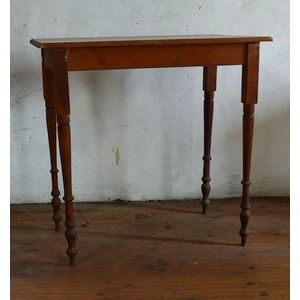Regency Mahogany Work Table
Regency mahogany work table, c. 1820, the rectangular top above a single drawer, raised on four turned tapering legs, height 74 cm, width 55 cm, depth 45.5 cm. provenance: The Estate of Martyn Cook, Sydney
You must be a subscriber, and be logged in to view price and dealer details.
Subscribe Now to view actual auction price for this item
When you subscribe, you have the option of setting the currency in which to display prices to $Au, $US, $NZ or Stg.
This item has been sold, and the description, image and price are for reference purposes only.
- Mahogany - Mahogany is a dense, close grained red-coloured timber from the West Indies and Central America. It was first imported into Europe in the the early 18th century and its use continued through the 19th century. It was popular for furniture making because of its strength, the wide boards available, the distinctive grain on some boards, termed flame mahogany and the rich warm colour of the timber when it was polished.. The "flame" was produced where a limb grew out from the trunk of the tree, and this timber was usually sliced into veneers for feature panels on doors, backs and cornices.
Some terms used to describe mahogany relate to the country from which it originally came, such as "Cuban" mahogany, "Honduras" mahogany etc. However unless the wood has been tested the names assigned are more a selling feature, rather than a true indication of the timber's origin. - Regency Period - The Regency period in English furniture design refers to the period when King George III, was declared unfit to rule in 1811, and his son ruled as proxy as Prince Regent, until 1820, and then, after the death of his father as George IV until his death in 1830. The Regency period was preceded by the Georgian period (George I, George II, and George III: 1714 - 1811), and was followed by the William IV period, which only lasted until 1837 when William IV died as was succeeded by Queen Victoria.
- Turning - Any part of a piece of furniture that has been turned and shaped with chisels on a lathe. Turned sections include legs, columns, feet, finials, pedestals, stretchers, spindles etc. There have been many varieties and fashions over the centuries: baluster, melon, barley-sugar, bobbin, cotton-reel, rope-twist, and so on. Split turning implies a turned section that has been cut in half lengthwise and applied to a cabinet front as a false decorative support.
- Provenance - A term used to describe the provable history of an antique or work of art, and thus an additional aid to verifying its authenticity. Provenance can have an inflating effect on the price of an item, particularly if the provenance relates to the early settlement of Australia, a famous person, or royalty. Less significant are previous sales of the item through an auction house or dealer.
This item has been included into following indexes:
- tables, purpose or type - sewing and work 363
- tables, small, period or style
Visually similar items

A French walnut side table fitted with four small drawers. 83 cm high, 40 cm wide, 24 cm deep.
Sold by
in
for
You can display prices in $Au, $US, $NZ or Stg.

A French mahogany and marble top single drawer bedside cabinet, 70 cm high
Sold by
in
for
You can display prices in $Au, $US, $NZ or Stg.

An Australian side table with turned legs, 19th century. 77 cm high, 78 cm wide, 45 cm deep
Sold by
in
for
You can display prices in $Au, $US, $NZ or Stg.

A small Georgian mahogany 'D' end side table 123 cm wide, 61 cm deep, 72 cm high
Sold by
in
for
You can display prices in $Au, $US, $NZ or Stg.
